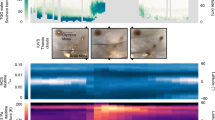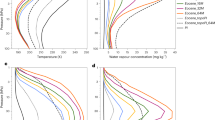Abstract
Hydrogen radicals are produced in the martian atmosphere by the photolysis of water vapour and subsequently initiate catalytic cycles that recycle carbon dioxide from its photolysis product carbon monoxide1,2. These processes provide a qualitative explanation for the stability of the atmosphere of Mars, which contains 95 per cent carbon dioxide. Balancing carbon dioxide production and loss based on our current understanding of the gas-phase chemistry in the martian atmosphere has, however, proven to be difficult3,4,5. Interactions between gaseous chemical species and ice cloud particles have been shown to be key factors in the loss of polar ozone observed in the Earth’s stratosphere6, and may significantly perturb the chemistry of the Earth’s upper troposphere7. Water-ice clouds are also commonly observed in the atmosphere of Mars8,9,10 and it has been suggested previously that heterogeneous chemistry could have an important impact on the composition of the martian atmosphere3,4,5,11. Here we use a state-of-the-art general circulation model together with new observations of the martian ozone layer12,13,14,15 to show that model simulations that include chemical reactions occurring on ice clouds lead to much improved quantitative agreement with observed martian ozone levels in comparison with model simulations based on gas-phase chemistry alone. Ozone is readily destroyed by hydrogen radicals and is therefore a sensitive tracer of the chemistry that regulates the atmosphere of Mars. Our results suggest that heterogeneous chemistry on ice clouds plays an important role in controlling the stability and composition of the martian atmosphere.
This is a preview of subscription content, access via your institution
Access options
Subscribe to this journal
Receive 51 print issues and online access
$199.00 per year
only $3.90 per issue
Buy this article
- Purchase on Springer Link
- Instant access to full article PDF
Prices may be subject to local taxes which are calculated during checkout




Similar content being viewed by others
References
McElroy, M. B. & Donahue, T. M. Stability of the Martian atmosphere. Science 177, 986–988 (1972)
Parkinson, T. D. & Hunten, D. M. Spectroscopy and aeronomy of O2 on Mars. J. Atmos. Sci. 29, 1380–1390 (1972)
Atreya, S. K. & Blamont, J. E. Stability of the Martian atmosphere: possible role of heterogeneous chemistry. Geophys. Res. Lett. 17, 287–290 (1990)
Atreya, S. K. & Gu, Z. G. Stability of the Martian atmosphere: Is heterogeneous catalysis essential? J. Geophys. Res. 99, 13133–13145 (1994)
Krasnopolsky, V. A. Photochemistry of the Martian atmosphere: Seasonal, latitudinal, and diurnal variations. Icarus 185, 153–170 (2006)
Solomon, S. Stratospheric ozone depletion: A review of concepts and history. Rev. Geophys. 37, 275–316 (1999)
Jaeglé, L. et al. Photochemistry of HO x in the upper troposphere at northern midlatitudes. J. Geophys. Res. 105, 3877–3892 (2000)
Clancy, R. T. et al. Water vapor saturation at low altitudes around Mars aphelion: A key to Mars climate? Icarus 122, 36–62 (1996)
Akabane, T., Iwasaki, K., Saito, Y. & Narumi, Y. Martian late-northern-winter polar hood opacities and non-visibility of a surface cap: 1975 and 1990 observations. Astron. Astrophys. 277, 302–308 (1993)
Mateshvili, N. et al. Martian ice cloud distribution obtained from SPICAM nadir UV measurements. J. Geophys. Res. 112 10.1029/2006JE002827 (2007)
Anbar, A. D., Leu, M. T., Nair, H. A. & Yung, Y. L. Adsorption of HOx on aerosol surfaces: Implications for the atmosphere of Mars. J. Geophys. Res. 98, 10933–10940 (1993)
Perrier, S. et al. Global distribution of total ozone on Mars from SPICAM/MEX UV measurements. J. Geophys. Res. 111 10.1029/2006JE002681 (2006)
Clancy, R. T. et al. Mars ozone measurements near the 1995 aphelion: Hubble space telescope ultraviolet spectroscopy with the faint object spectrograph. J. Geophys. Res. 101, 12777–12783 (1996)
Clancy, R. T., Wolff, M. J. & James, P. B. Minimal aerosol loading and global increases in atmospheric ozone during the 1996–1997 Martian northern spring season. Icarus 138, 49–63 (1999)
Fast, K. et al. Ozone abundances on Mars from infrared heterodyne spectra I: Acquisition, retrieval, and anticorrelation with water vapor. Icarus 181, 419–431 (2006)
Lefèvre, F., Lebonnois, S., Montmessin, F. & Forget, F. Three-dimensional modeling of ozone on Mars. J. Geophys. Res. 109 10.1029/2004JE002268 (2004)
Moudden, Y. & McConnell, J. C. Three-dimensional on-line chemical modeling in a Mars general circulation model. Icarus 188, 18–34 (2007)
Montmessin, F., Forget, F., Rannou, P., Cabane, M. & Haberle, R. M. Origin and role of water ice clouds in the Martian water cycle as inferred from a general circulation model. J. Geophys. Res. 109 10.1029/2004JE002284 (2004)
Smith, M. D. Interannual variability in TES atmospheric observations of Mars during 1999–2003. Icarus 167, 148–165 (2004)
Clancy, R. T. & Nair, H. Annual (perihelion–aphelion) cycles in the photochemical behavior of the global Mars atmosphere. J. Geophys. Res. 101, 12785–12790 (1996)
Lebonnois, S. et al. Vertical distribution of ozone on Mars as measured by SPICAM/Mars-Express using stellar occultations. J. Geophys. Res. 111 10.1029/2005JE002643 (2006)
Montabone, L., Lewis, S. R. & Read, P. L. Interannual variability of Martian dust storms in assimilation of several years of Mars Global Surveyor observations. Adv. Space Res. 36, 2146–2155 (2005)
Cooper, P. L. & Abbatt, J. P. Heterogeneous interactions of OH and HO2 radicals with surfaces characteristic of atmospheric particulate matter. J. Phys. Chem. 100, 2249–2254 (1996)
Sander, S. P. et al. Chemical Kinetics and Photochemical Data for Use in Atmospheric Studies, Evaluation Number 15. JPL Publ. 06–2 (Jet Propulsion Lab., Pasadena, 2006)
Barth, C. A. et al. Mariner 9 ultraviolet spectrometer experiment: Seasonal variation of ozone on Mars. Science 179, 795–796 (1973)
Encrenaz, T. et al. A stringent upper limit of the H2O2 abundance in the Martian atmosphere. Astron. Astrophys. 396, 1037–1044 (2002)
Fouchet, T. et al. Martian water vapor: Mars Express PFS/LW observations. Icarus 190, 32–49 (2007)
Encrenaz, T. et al. Hydrogen peroxide on Mars: Evidence for spatial and seasonal variations. Icarus 170, 424–429 (2004)
Encrenaz, T. et al. Simultaneous mapping of H2O and H2O2 on Mars from infrared high-resolution imaging spectroscopy. Icarus 195, 547–556 (2008)
Clancy, R. T., Sandor, B. J. & Moriarty-Schieven, G. H. A measurement of the 362 Ghz absorption line of Mars atmospheric H2O2 . Icarus 168, 116–121 (2004)
Acknowledgements
Much of this work was done while F.L. was on leave from CNRS at the Instituto de Astrofísica de Andalucía (Granada, Spain). We thank M. Smith, who provided the TES data.
Author information
Authors and Affiliations
Corresponding author
Supplementary information
Supplementary Information
The file contains Supplementary Notes and related Supplementary Figures 1-3 with Legends. (PDF 854 kb)
Rights and permissions
About this article
Cite this article
Lefèvre, F., Bertaux, JL., Clancy, R. et al. Heterogeneous chemistry in the atmosphere of Mars. Nature 454, 971–975 (2008). https://doi.org/10.1038/nature07116
Received:
Accepted:
Issue Date:
DOI: https://doi.org/10.1038/nature07116
This article is cited by
-
Retrieval of Martian ozone and dust from SPICAM spectrometer for MY27–MY28
Journal of Earth System Science (2019)
-
NOMAD, an Integrated Suite of Three Spectrometers for the ExoMars Trace Gas Mission: Technical Description, Science Objectives and Expected Performance
Space Science Reviews (2018)
-
The Atmospheric Chemistry Suite (ACS) of Three Spectrometers for the ExoMars 2016 Trace Gas Orbiter
Space Science Reviews (2018)
-
Elevated atmospheric escape of atomic hydrogen from Mars induced by high-altitude water
Nature Geoscience (2017)
-
Mars: a small terrestrial planet
The Astronomy and Astrophysics Review (2016)
Comments
By submitting a comment you agree to abide by our Terms and Community Guidelines. If you find something abusive or that does not comply with our terms or guidelines please flag it as inappropriate.



